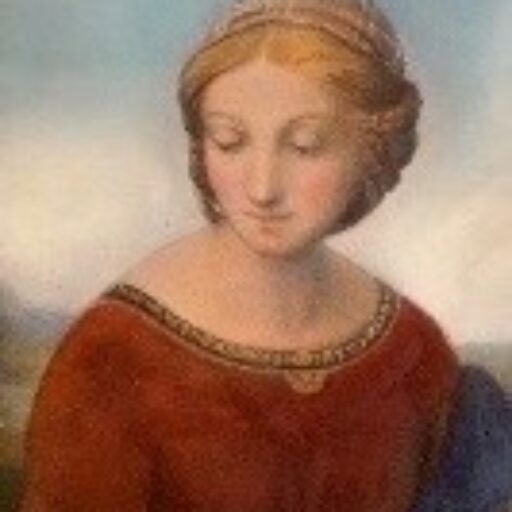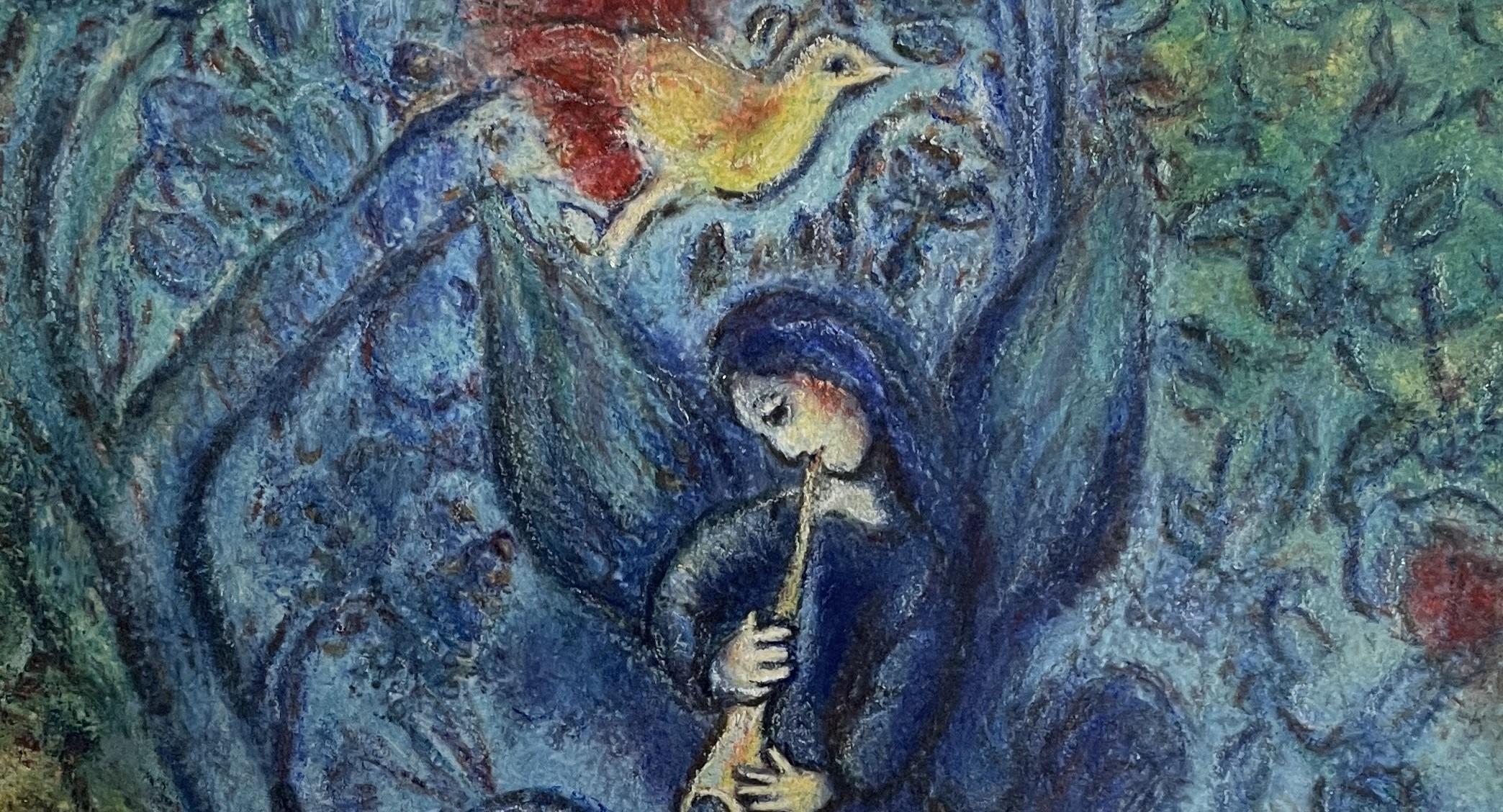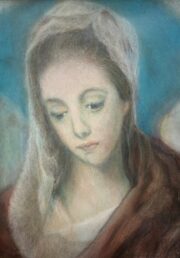日本語-Englishー台灣華語
エル・グレコ「聖マリアの肖像」
多くの日本人と同じように、私がエル・グレコをはじめて観たのは倉敷の紡績工場跡に建てられた大原美術館である。日本がまだ貧しかった時代に日本にやってきた作品だ。大原美術館にある「受胎告知」は、エル・グレコの美を凝縮したとても素晴らしい作品である。天を見上げる潤んだマリアの瞳が忘れられない。本家のプラド美術館にあるエル・グレコはどれもあまりに大きく、たくさんの人物が描かれていて目眩がしてしまう。エル・グレコが実は乱視であったというのは本当かもしれない。チェコのプラハにある美術館で、白と黒で描いたエル・グレコを観たことがあるが、色彩がないのに、そこにはエル・グレコの色が残像として見えるようだった。大胆なタッチの割に予想以上に滑らかな絵肌によるところが大きいのかもしれない。
ベネチア支配下のクレタ島に生まれたエル・グレコは、スペインに永住する以前ベニスに滞在しており、そこでティツィアーノやティントレットの色彩の秘密を学びとったに違いない。 エル・グレコの絵の魅力はやはり印象的なマリアの容姿にある。私は聖マリアを描くことにする。殆ど肌を露わにしないエル・グレコの絵にあって、この聖マリアでは珍しく乳房がこぼれ出ている。その乳房は何事もスリムな聖マリアの絵にあって、意外に豊満で、釣鐘型の乳房が良く似合っている。授乳しようとする聖マリアは微かに口元に微笑みを浮べながら、全体には深い憂愁をたたえ、どこか悲しげである。眼差しは中空をさ迷っている。そこには授乳する母の喜びよりは、悲しい愛を感じてしまう。背景の空には、嵐のような雲が流れ、不安な未来を暗示している。水色の空と補色の関係にある赤い服は、嵐の雲に呼応して不安な気持ちを増幅させている。聖マリアのかぶるベールは、微妙なタッチが縦横に巡らされ、複雑な心理をあらわしているようだ。
エル・グレコは人間的にも独特であったと伝えられている。ティツィアーノとさほど年代が違わないとすると、エル・グレコの絵はかなり独特である。異邦人としてトレドに住み着いたエル・グレコの描く人物は、頭が極端に小さく、体が細長い。どの絵も渦巻き状によじれ、天を仰いでいる。眼の中心は折れ曲がり、写実的描写を超えた感情的高まりに驚かされる。
エル・グレコの絵を描いていると深い憂いを秘めた神秘的な色彩が、独特の揺らめくような形態と相乗効果を発揮しながら、狂おしく高まる宗教的情熱を見事に表現していることを強く感じる。 エル・グレコの時代によくこれだけ独特のスタイルの絵画が受け入れられたものだとずっと不思議に思っていたが、スペインに実際行ってみると、スペインの若く美しい女性はエル・グレコの絵とはいかないまでも、ほっそとした顔立ちですらりと背が高い。当時のマニエリズムばかりがエル・グレコの絵を規定しているのでもなさそうだ。
三方を川に囲まれた難攻不落の城塞都市トレドは、エル・グレコが唯一残した風景画そのままに、今も16世紀の街並みのまま歩みを止め、奇跡のようにエル・グレコの面影を忍ばせている。
St. Anne
Just like many Japanese people, the first time I saw El Greco was at the Ohara Museum of Art, which was built on the site of a spinning mill in Kurashiki. It was during a time when Japan was still poor that his works came to Japan. The “Annunciation” at the Ohara Museum of Art is a truly wonderful piece that encapsulates the beauty of El Greco. I can’t forget the moist eyes of Maria looking up to the heavens. The El Greco in the Prado Museum are all so large, with so many people depicted, that it’s dizzying. It might be true that El Greco had astigmatism. I have seen an El Greco in black and white at a museum in Prague, Czech Republic, and though it was without color, it seemed as if El Greco’s colors were visible as afterimages. This might be due to the unexpectedly smooth texture of the painting despite its bold strokes. Born on the island of Crete, which was under Venetian rule, El Greco, before settling permanently in Spain, must have learned the secrets of color from Titian and Tintoretto during his stay in Venice.
The charm of El Greco’s paintings is in the impressive appearance of Maria. I decide to paint the Holy Mary. In El Greco’s paintings, where almost no skin is exposed, this Holy Mary is unusual in that her breast spills out. This breast, surprisingly voluptuous for the otherwise slim depictions of Holy Mary, suits her well, resembling a bell shape. The Holy Mary, attempting to nurse, has a faint smile on her lips, yet carries a deep melancholy throughout, appearing somewhat sad. Her gaze wanders through the middle air, feeling more of a sad love than the joy of a nursing mother. In the background sky, storm-like clouds flow, hinting at an uneasy future. The red dress, in complementary contrast to the blue sky, amplifies the uneasy feeling, resonating with the storm clouds. The veil covering Holy Mary is intricately touched in vertical and horizontal strokes, seemingly expressing complex emotions.
El Greco is reported to have been unique as a person as well. If he was not much different in age from Titian, El Greco’s paintings are quite distinctive. The characters drawn by El Greco, who settled in Toledo as a foreigner, have extremely small heads and elongated bodies. Each painting twists in a spiral, looking up to the heavens. The centers of the eyes are bent, and one is surprised by the emotional intensity that surpasses realistic depiction. Painting El Greco’s works, I strongly feel that the deep melancholy and mystical colors, combined with a unique wavering form, magnificently express a frantic religious fervor.
I have always wondered how such a unique style of painting was accepted in El Greco’s time, but upon visiting Spain, I found that young and beautiful Spanish women, though not exactly like El Greco’s paintings, have slender faces and tall statures. It seems that not only Mannerism defined El Greco’s paintings at that time.
The impregnable fortress city of Toledo, surrounded by rivers on three sides, still stops in its tracks with the streetscape of the 16th century, miraculously retaining the image of El Greco.
埃爾·格列柯《聖瑪麗亞肖像》
就像許多日本人一樣,我第一次見到埃爾·格列柯的作品是在倉敷的一家紡織工廠遺址上建立的大原美術館。那是日本還很貧窮的時候,這些作品來到日本。大原美術館收藏的《受孕告知》是一件凝練了埃爾·格列柯之美的絕妙作品。那濕潤的瑪麗亞仰望天空的眼神令人難以忘懷。位於普拉多美術館的埃爾·格列柯作品都太大了,畫中人物眾多,讓人眼花繚亂。埃爾·格列柯實際上可能有散光的說法或許是真的。我在捷克的布拉格的一家美術館看過他用黑白畫的作品,雖然沒有顏色,但似乎能看到埃爾·格列柯色彩的殘影。可能是因為大膽的筆觸出乎意料地平滑所致。埃爾·格列柯出生於威尼斯統治下的克里特島,在定居西班牙之前,他曾在威尼斯停留,肯定學到了提香和丁托列托的色彩秘密。
埃爾·格列柯畫作的魅力無疑在於給人深刻印象的瑪麗亞形象。我決定畫聖瑪麗亞。在埃爾·格列柯幾乎不露肌膚的畫作中,這幅聖瑪麗亞的畫作中乳房罕見地外露。那乳房在畫中的聖瑪麗亞看起來意外地豐滿,鐘形的乳房非常適合她。試圖哺乳的聖瑪麗亞嘴角微微帶笑,整體上卻充滿了深深的憂愁,看起來有些悲傷。她的目光彷彿在空中遊蕩。從中感受到的不僅是哺乳母親的喜悅,更多的是悲傷的愛。背景的天空中,暴風雨般的雲彷彿暗示著不安的未來。水藍色的天空與紅色服裝的互補色關係,與暴風雲相呼應,增強了不安的情緒。聖瑪麗亞的面紗上,細膩的筆觸橫豎交錯,似乎表達著複雜的心理。
埃爾·格列柯在人性上也被傳為獨特。如果他和提香的年代不太相差,那麼埃爾·格列柯的畫作確實非常獨特。作為一個外來者定居在托萊多的埃爾·格列柯畫中的人物,頭部極小,身體修長。每幅畫作都呈現螺旋狀扭曲,仰望天空。眼睛的中心折彎,超越寫實描繪的情感高漲令人驚訝。畫埃爾·格列柯的作品時,深感其作品中所蘊含的深沉憂愁和神秘色彩,以獨特的波動形態相結合,華麗地表達了瘋狂上升的宗教熱情。
我一直對埃爾·格列柯在其時代能如此被接受的獨特風格感到好奇。但實際去了西班牙後,發現當地年輕美麗的女性雖然不完全符合埃爾·格列柯的描繪,但臉型纖細,身材高挑。看來並不是只有當時的曼尼埃主義風格定義了埃爾·格列柯的畫作。
被三面河流圍繞的難攻不落的城塞城市托萊多,如同埃爾·格列柯唯一留下的風景畫一般,今天仍保留著16世紀的街道景觀,奇蹟般地保留著埃爾·格列柯的影子。


